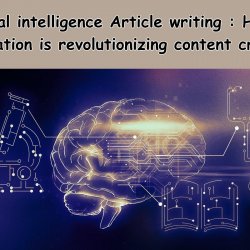How the democratization of Artificial Intelligence affects enterprise IT

 Increased Adoption of AI Solutions
Increased Adoption of AI Solutions
The increased adoption of AI (Artificial Intelligence) solutions across various industries has been fueled by the growing recognition of its transformative potential. Here’s how AI solutions are being adopted and integrated across different sectors:
- Automated Customer Support: AI-powered chatbots and virtual assistants are increasingly being used to handle customer inquiries and provide real-time support. These solutions can effectively handle routine customer queries, improving overall customer service experiences.
- Personalized Marketing and Recommendations: AI algorithms analyze customer data to provide personalized product recommendations and targeted marketing campaigns. This enhances customer engagement and increases the likelihood of conversions and sales.
- Enhanced Data Analytics: AI-driven data analytics tools help businesses derive valuable insights from large datasets, enabling them to make informed decisions and identify trends that may not be apparent through traditional analytics methods.
- Predictive Maintenance in Manufacturing: AI-based predictive maintenance systems monitor equipment performance and identify potential issues before they lead to costly breakdowns. This proactive approach helps industries minimize downtime and reduce maintenance costs.
- Healthcare Diagnostics and Treatment: AI is revolutionizing healthcare through improved diagnostics, personalized treatment plans, and the development of advanced medical imaging and analysis tools. AI-powered systems can assist healthcare professionals in making more accurate diagnoses and treatment recommendations.
Enhanced Data Analysis and Insights
As technology continues to advance at a rapid pace, one aspect that has been gaining significant attention is Artificial Intelligence (AI). Once thought of as a concept solely reserved for science fiction, AI is now becoming more accessible and affordable for enterprises. This democratization of AI is having a profound impact on the world of enterprise IT, bringing about enhanced data analysis and insights.
Gone are the days when I was only accessible to large corporations with high budgets. With new advancements and innovations in technology, AI is gradually becoming more democratized. This means that even small and medium sized enterprises can now leverage the power of AI to analyze data and gain valuable insights.
One of the main reasons for this democratization is the development of user-friendly tools that make it easy for businesses to incorporate AI into their operations. These tools allow enterprises to utilize AI without needing extensive knowledge or expertise in the field. As a result, companies are now able to harness the potential of AI without having to invest significant amounts of time and resources into training their employees or hiring specialized professionals.
Moreover, with cloud based solutions becoming increasingly prevalent in today’s business landscape, enterprises no longer need to invest in expensive hardware and infrastructure to implement AI technologies. This further reduces the barrier to entry for businesses looking to incorporate these advanced analytics tools into their operations.
The democratization of AI also brings about increased competition among technology providers, which ultimately results in improved efficiency and lower costs for businesses. With more players entering the market, there is an abundance of options for companies looking to adopt AI technologies. This means that businesses can choose from various pricing models and find an option that best suits their budget and needs.
Improved Customer Experience
Artificial Intelligence (AI) has revolutionized the way businesses interact with their customers, enabling them to deliver personalized and seamless experiences. Here’s how AI contributes to improved customer experiences:
- Chatbots and Virtual Assistants: AI-powered chatbots provide instant and round-the-clock customer support, addressing common queries and concerns. These virtual assistants can guide customers through their purchase journey, provide product recommendations, and offer timely assistance, thereby enhancing the overall customer experience.
- Personalized Recommendations and Targeted Marketing: AI algorithms analyze customer data to provide personalized product recommendations and targeted marketing campaigns. By understanding customer preferences and behavior, businesses can offer tailored suggestions and promotions, increasing customer engagement and satisfaction.
- Natural Language Processing (NLP) for Enhanced Communication: NLP enables AI systems to understand and respond to human language, facilitating more natural and effective communication between businesses and customers. This technology powers voice assistants and enables seamless interactions, creating a more user-friendly and intuitive customer experience.
- Predictive Analytics for Anticipating Customer Needs: AI-driven predictive analytics help businesses anticipate customer needs and preferences. By analyzing past behaviors and patterns, businesses can proactively offer relevant products and services, enhancing customer satisfaction and fostering long-term relationships.
- Improved Self-Service Options: AI-powered self-service options, such as interactive FAQs and knowledge bases, empower customers to find solutions to their queries independently. This not only reduces the load on customer support teams but also provides customers with quick and convenient solutions, leading to a more positive overall experience.
Streamlined Business Operations
The world of business is always evolving, and one of the most significant changes in recent years has been the widespread adoption of Artificial Intelligence (AI). This technology is revolutionizing industries across the board, and it has made its way into enterprise IT, streamlining business operations like never before. And the best part? AI is becoming more accessible and user friendly, thanks to its democratization.
So what exactly does this mean for enterprise IT?
First, let’s define what we mean by “democratization” of AI. In simple terms, it refers to the process of making AI more accessible and usable for individuals or businesses without extensive technical knowledge or resources. In other words, AI is no longer limited to experts in the field; it is now within reach for any organization looking to boost their efficiency and productivity.
One of the primary benefits of democratization is that it eliminates the need for specialized skills in data science and programming. With user-friendly interfaces and pre-built models, businesses can now implement AI solutions without having a dedicated team of experts. This not only saves time but also reduces costs for organizations.
Moreover, democratization allows businesses to customize AI solutions according to their specific needs. Instead of relying on generic “one size fits all” models, companies can now personalize AI algorithms to cater to their unique requirements accurately. This level of customization can significantly impact business operations by providing tailored insights that lead to better decision making.
But what makes this shift towards democratization possible?
One crucial factor is advancements in technology that have made AI more accessible and user friendly than ever before. Cloud computing platforms have played a significant role in this by providing easy access to powerful computing resources required for building and deploying AI models.
Integration of AI into Existing IT Infrastructure
Integrating AI into existing IT infrastructure can be a complex process, but it offers numerous benefits in terms of enhanced efficiency, automation, and data-driven decision-making. Here are some key steps and considerations for successfully integrating AI into your current IT infrastructure:
- Assessment of Current Infrastructure: Begin by assessing your current IT infrastructure, including hardware, software, networks, and data storage capabilities. Identify any gaps or areas that require improvement to support AI integration effectively.
- Define Clear Objectives and Use Cases: Clearly define your objectives for integrating AI and identify specific use cases where AI can add value to your existing infrastructure. Determine how AI can streamline processes, improve decision-making, and enhance overall performance.
- Data Preparation and Quality Enhancement: Ensure that your data is properly prepared and of high quality before integrating AI. Implement data cleansing and normalization processes to ensure that the AI models receive accurate and reliable data for analysis and decision-making.
- Choose the Right AI Solutions: Select AI solutions that align with your business goals and integrate seamlessly with your existing IT infrastructure. Choose AI technologies that are scalable, flexible, and compatible with your current systems and software.
- Evaluate Security and Compliance Measures: Prioritize data security and compliance when integrating AI into your infrastructure. Implement robust security measures, such as encryption, access controls, and authentication protocols, to protect sensitive data and ensure compliance with relevant regulations.
Empowerment of Non-Technical Users
With the rapid advancement of technology, Artificial Intelligence (AI) has become increasingly accessible to users without a technical background. This empowerment of nontechnical users has sparked a new wave of innovation and potential in the world of enterprise IT. In this section, we will delve into the concept of democratization of AI and how it is changing the landscape of enterprise IT.
The democratization of AI refers to the process of making AI technology more accessible to nontechnical users. This means that individuals without specialized technical skills can now utilize AI tools and platforms for their business needs. This shift has been made possible through advancements in user-friendly interfaces and simplified coding methods, making it easier for nontechnical users to understand and use AI technology.
One major advantage of this democratization is that it allows businesses to harness the power of AI without having to rely solely on expensive and specialized data scientists or engineers. With AI becoming more accessible, companies are no longer limited by their budget or resources when it comes to implementing innovative solutions powered by AI.
The increased accessibility of AI also brings about a new wave of challenges for enterprises. One such challenge is ensuring that nontechnical users have proper training and support to effectively use these advanced tools. Without proper training, users may not fully understand the capabilities and limitations of AI, leading to incorrect usage or interpretation of results.
Hence, it is crucial for organizations to invest in user-friendly interfaces and comprehensive training programs for nontechnical employees who will be using AI tools. This will not only improve the overall efficiency and accuracy but also boost employee confidence in utilizing these powerful tools.
Challenges in Skill Development
- Rapid Technological Advancements: The rapid pace of technological advancements in AI often makes it challenging for individuals to keep up with the latest developments and acquire relevant skills, leading to a significant skill gap in the workforce.
- Complexity of AI Technologies: AI technologies can be complex and require a deep understanding of programming, algorithms, and data analysis. Acquiring the necessary skills to work with AI systems effectively can be daunting for individuals without a technical background.
- Lack of Access to Quality Education: Access to quality education and training programs in AI may be limited, especially in certain regions or communities. This lack of access can hinder the development of a skilled workforce capable of leveraging AI technologies.
- Cost of Training and Education: Training and education programs for AI often come with a high price tag, making it difficult for individuals, especially those from disadvantaged backgrounds, to afford the necessary training to develop AI-related skills.
- Need for Continuous Learning and Adaptation: AI technologies evolve rapidly, requiring individuals to engage in continuous learning and upskilling to stay relevant in the field. The need for ongoing education and skill development can be challenging for individuals balancing work and other commitments.
- Ethical and Social Implications of AI: Understanding the ethical and social implications of AI is crucial for developing responsible AI solutions. However, addressing these complex issues requires interdisciplinary knowledge and expertise, which can be challenging to acquire through traditional educational pathways.
- Integration of AI into Non-Technical Fields: Integrating AI into non-technical fields, such as healthcare, finance, and law, requires individuals to have a combination of AI skills and domain-specific knowledge. Bridging this interdisciplinary gap can be challenging for professionals seeking to leverage AI in their respective fields.
- Lack of Diversity and Inclusion in AI Development: The lack of diversity and inclusion in AI development can lead to biased algorithms and technologies that do not address the needs of diverse communities. Overcoming this challenge requires a concerted effort to promote diversity in AI education and development.
Ethical and Regulatory Concerns
As technology continues to advance, the use of Artificial Intelligence (AI) in enterprise IT has become increasingly prevalent. This integration of AI offers many benefits, such as increased efficiency and cost savings, making it a desirable tool for businesses. However, with this advancement comes ethical and regulatory concerns that cannot be ignored.
One of the primary ethical issues surrounding the use of AI in enterprise IT is the potential for biased decision making. AI algorithms are often trained on historical data, which can reflect societal biases and inequalities. As a result, these biases can be perpetuated through AI systems, leading to discriminatory outcomes. For example, biased hiring practices or loan decisions based on race or gender.
Moreover, with the democratization of AI, where the technology is becoming more accessible to businesses of all sizes, there is a concern that smaller companies may not have the resources or expertise to properly address ethical considerations. This could potentially lead to misuse or abuse of AI technology without proper regulation and oversight.
Another aspect that raises red flags is data privacy and security. With AI systems collecting and analyzing vast amounts of data from various sources, there is a risk of sensitive information being compromised. This presents significant challenges for businesses in terms of safeguarding consumer data and complying with data protection regulations such as GDPR.
Furthermore, there have been instances where AIpowered systems have made decisions without any human intervention or oversight. This can lead to questions about who is ultimately responsible for the actions taken by these machines if something were to go wrong.
You can also read:
almabetter data science course reviews
almabetter data science pay after placement
excelr data science course reviews






Ingen kommentarer endnu